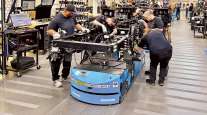Trucking Industry Payrolls Dip by 100 in April

For-hire trucking lost 100 jobs in April, while overall payrolls increased by 211,000, the Labor Department reported May 5.
The unemployment rate fell to 4.4%, the lowest level since May 2007, and wage gains rose 2.5% year-over-year, Bloomberg News reported.
The median forecast in a Bloomberg survey of economists called for a 190,000 advance.
Transportation and warehousing, which includes trucking, added 3,500 positions. The transit and ground passenger transportation sector lost 4,400 positions, the Bureau of Labor Statistics reported.
RELATED: Jobless claims declined more than forecast last week
The report showed revisions to the previous two months subtracted 6,000 jobs from payrolls. The first quarter saw a 176,000 average monthly increase after an 187,000 average pace in 2016, Bloomberg reported.
Support activities for transportation gained 2,200 jobs, and the couriers and messengers sector added 3,200 position, according to BLS.
“Labor market conditions remain robust and continue to tighten,” Ward McCarthy, chief financial economist at Jefferies in New York, who had forecast a payroll gain of 220,000 told Bloomberg. “This data will keep the Fed on track for a preferred 2017 normalization timeline of rate hikes in June and September and the first step toward balance-sheet normalization in December.”
RELATED: Companies boost payrolls by 177,000 in April, ADP says
Construction added 5,000 jobs in April, and manufacturing jobs increased by 6,000, according to the report.
Total private employment, which excludes government agencies, climbed by 194,000 in April, after a 77,000 advance the prior month. Government payrolls rose by 17,000 in April, including a 6,000 decline at federal agencies and 23,000 increase at state and local governments, Bloomberg reported.
Dwindling labor-market slack also is helping workers gain bargaining power. Beyond the broad unemployment rate, measures of spare workforce capacity that are favored by Trump administration officials showed further progress toward pre-recession levels in April.
The underemployment rate, a measure that includes those working part time who would take a full-time job if it were available, dropped to 8.6%, the lowest since November 2007, just before the last recession began. It was from 8.9% in March.
The number of discouraged workers fell by 5,000 in April to 460,000. It was 363,000 the month the last recession started. The participation rate, which indicates the share of working-age people who are employed or looking for work, decreased to 62.9% from 63% the prior month.




